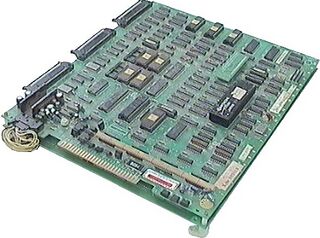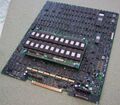Difference between revisions of "Sega System 16"
From Sega Retro
| Line 1: | Line 1: | ||
| − | The '''Sega System 16''' is an | + | {{ConsoleBob |
| + | | logos= | ||
| + | | consoleimage=system16a_motherboard.jpg | ||
| + | | imgwidth=320 | ||
| + | | name= | ||
| + | | maker=[[Sega]] | ||
| + | | releases={{releases | ||
| + | | arcade_date_world=1985 | ||
| + | }} | ||
| + | }} | ||
| + | The '''Sega System 16''' is an arcade board released by [[Sega]] in 1985 as a 16-bit successor to the [[Sega System 1]]. Throughout its lifespan, there would be around forty games released on this hardware, making it one of Sega's most successful hardware designs. It was produced in three variants, the Pre-System 16, System 16A and System 16B, though the only differences between the three are clock speeds. | ||
| + | |||
| + | The System 16 is the home to many of Sega's most successful franchises, including ''[[Shinobi]]'', ''[[Fantasy Zone]]'', ''[[Altered Beast]]'' and ''[[Golden Axe]]''. It popularised the use of the [[Motorola]] [[68000]] CPI and [[Zilog]] [[Z80]] combo, something which was copied for [[Capcom]]'s successful CPS-1 and CPS-2 boards (among other arcade systems of the day), as well as most notably, the [[Sega Mega Drive]]. | ||
In order to prevent piracy, as well as illegal bootleg games, many System 16 boards used an encryption system. A Hitachi [[FD1094]] chip, containing the main CPU as well as the decryption key, was used in place of a regular CPU. | In order to prevent piracy, as well as illegal bootleg games, many System 16 boards used an encryption system. A Hitachi [[FD1094]] chip, containing the main CPU as well as the decryption key, was used in place of a regular CPU. | ||
| − | == | + | ==Technical Specifications== |
*Main CPU: [[Motorola]] [[68000]] @ 10 MHz | *Main CPU: [[Motorola]] [[68000]] @ 10 MHz | ||
| Line 12: | Line 24: | ||
*Graphical Capabilities: 128 onscreen [[sprite]]s, 2 tile layers, 1 text layer, 1 sprite layer, sprite scaling. | *Graphical Capabilities: 128 onscreen [[sprite]]s, 2 tile layers, 1 text layer, 1 sprite layer, sprite scaling. | ||
| − | == | + | ==Gallery== |
| − | + | ===Pre-System 16=== | |
<gallery> | <gallery> | ||
File:pre-system16.jpg|Motherboard | File:pre-system16.jpg|Motherboard | ||
</gallery> | </gallery> | ||
| − | + | ===Sega System 16A=== | |
<gallery> | <gallery> | ||
File:system16a_motherboard.jpg|Motherboard (side 1) | File:system16a_motherboard.jpg|Motherboard (side 1) | ||
| Line 24: | Line 36: | ||
</gallery> | </gallery> | ||
| − | + | ===Sega System 16B=== | |
<gallery> | <gallery> | ||
File:system16b_motherboard.png|Motherboard | File:system16b_motherboard.png|Motherboard | ||
</gallery> | </gallery> | ||
| − | ==List of Pre System 16 | + | ==List of Games== |
| + | ===Pre-System 16=== | ||
* ''[[Alien Syndrome]]'' (1987) | * ''[[Alien Syndrome]]'' (1987) | ||
* ''[[Body Slam]]'' / ''Dump Matsumoto'' (1986) | * ''[[Body Slam]]'' / ''Dump Matsumoto'' (1986) | ||
| Line 36: | Line 49: | ||
* ''[[Quartet 2]]'' (1987) | * ''[[Quartet 2]]'' (1987) | ||
| − | == | + | ===System 16A=== |
*''[[Action Fighter]]'' (1986) | *''[[Action Fighter]]'' (1986) | ||
*''[[Alex Kidd: The Lost Stars]]'' (1986) | *''[[Alex Kidd: The Lost Stars]]'' (1986) | ||
| Line 47: | Line 60: | ||
*''[[Wonder Boy III: Monster Lair]]'' (1988) | *''[[Wonder Boy III: Monster Lair]]'' (1988) | ||
| − | == | + | ===System 16B=== |
{{multicol| | {{multicol| | ||
*''[[Ace Attacker]]'' (1989) | *''[[Ace Attacker]]'' (1989) | ||
Revision as of 13:37, 7 December 2012

| |||||
| Sega System 16 | |||||
|---|---|---|---|---|---|
| Manufacturer: Sega | |||||
|
The Sega System 16 is an arcade board released by Sega in 1985 as a 16-bit successor to the Sega System 1. Throughout its lifespan, there would be around forty games released on this hardware, making it one of Sega's most successful hardware designs. It was produced in three variants, the Pre-System 16, System 16A and System 16B, though the only differences between the three are clock speeds.
The System 16 is the home to many of Sega's most successful franchises, including Shinobi, Fantasy Zone, Altered Beast and Golden Axe. It popularised the use of the Motorola 68000 CPI and Zilog Z80 combo, something which was copied for Capcom's successful CPS-1 and CPS-2 boards (among other arcade systems of the day), as well as most notably, the Sega Mega Drive.
In order to prevent piracy, as well as illegal bootleg games, many System 16 boards used an encryption system. A Hitachi FD1094 chip, containing the main CPU as well as the decryption key, was used in place of a regular CPU.
Contents
Technical Specifications
- Main CPU: Motorola 68000 @ 10 MHz
- Sound CPU: Zilog Z80 @ 4 MHz (5 MHz in System 16B)
- Sound Chip: Yamaha YM2151 @ 4 MHz (+ NEC uPD7751 ADPCM decoder in System 16B)
- Display Resolution: 320 x 224
- Colors: 4096
- Graphical Capabilities: 128 onscreen sprites, 2 tile layers, 1 text layer, 1 sprite layer, sprite scaling.
Gallery
Pre-System 16
Sega System 16A
Sega System 16B
List of Games
Pre-System 16
- Alien Syndrome (1987)
- Body Slam / Dump Matsumoto (1986)
- Major League (1985)
- Quartet (1987)
- Quartet 2 (1987)
System 16A
- Action Fighter (1986)
- Alex Kidd: The Lost Stars (1986)
- Fantasy Zone (1986)
- SDI (1987)
- Shinobi (1987)
- Sukeban Jansi Ryuko (1988)
- Tetris (1988)
- Time Scanner (1987)
- Wonder Boy III: Monster Lair (1988)
System 16B
- Ace Attacker (1989)
- Alien Syndrome (1987)
- Altered Beast / Juuouki (1988)
- Aurail (1990)
- Bay Route (1989)
- Bullet (1987)
- Charon (198?)
- Cotton (1991)
- Dunk Shot (1987)
- Dynamite Dux (1988)
- ESWAT (1989)
- Excite League (1989)
- Flash Point (1989)
- Golden Axe (1989)
- Heavyweight Champ (1988)
- M.V.P. (1989)
- Passing Shot (1988)
- Riot City (1991)
- Ryu Kyu (1990)
- Sonic Boom (1987)
- Sukeban Jansi Ryuko (1988)
- Super League (1988)
- Tetris (1988)
- Time Scanner (1987)
- Toryumon (1994)
- Tough Turf (1989)
- Wonder Boy III: Monster Lair (1988)
- Wrestle War (1989)
| Sega arcade boards |
|---|
| Originating in arcades |
|
77
78
79
80
81
82
83
84
85
86
87
88
89
90
91
92
93
94
95
96
97
98
99
|
| Console-based hardware |
|
84
85
86
87
88
89
90
91
92
93
94
95
96
97
98
99
00
01
02
03
04
05
06
07
08
09
10
11
12
13
14
|
| PC-based hardware |
|
05
06
07
08
09
10
11
12
13
14
15
16
17
18
19
20
21
22
23
|



